 No single big thing happened this week but it sure wasn’t empty. If it had been, I’d be posting a Trip Peek or some other pre-canned asynchronous bit. Instead, I’m making this post from four things that happened during my non-empty week. The picture at right was taken Wednesday at something I’ve been anticipating for quite some time. It’s Steve Earle appearing at The Mercantile Library as part of the Words and Music Series.
No single big thing happened this week but it sure wasn’t empty. If it had been, I’d be posting a Trip Peek or some other pre-canned asynchronous bit. Instead, I’m making this post from four things that happened during my non-empty week. The picture at right was taken Wednesday at something I’ve been anticipating for quite some time. It’s Steve Earle appearing at The Mercantile Library as part of the Words and Music Series.
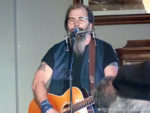

 The library was certainly full but everyone had at least a little breathing room. Steve’s song introductions were insightful although they probably weren’t any longer than normal. He often provides a good background for what is about to be heard. About the only song he didn’t provide much introduction to was the surprise opener, F the CC. Anyone wanting to hear that in a library missed a rare opportunity. Steve played several songs, read a complete story from Doghouse Roses along with excerpts from his novel I’ll Never Get Out of Here Alive, then stayed on stage to take questions. It was exactly what I’d hoped for.
The library was certainly full but everyone had at least a little breathing room. Steve’s song introductions were insightful although they probably weren’t any longer than normal. He often provides a good background for what is about to be heard. About the only song he didn’t provide much introduction to was the surprise opener, F the CC. Anyone wanting to hear that in a library missed a rare opportunity. Steve played several songs, read a complete story from Doghouse Roses along with excerpts from his novel I’ll Never Get Out of Here Alive, then stayed on stage to take questions. It was exactly what I’d hoped for.


 Cincinnati Gardens opened in 1949 and closed in 2016. On Monday, Ronnie Salerno posted some pictures of the recently begun demolition. That article can be read here and it should be. In addition to pictures from a very recent visit, it contains links to other pictures and other memories. It prompted me to take a few of my own pictures when I was next in the neighborhood which turned out to be Friday. Of course I have my own memories of The Gardens.
Cincinnati Gardens opened in 1949 and closed in 2016. On Monday, Ronnie Salerno posted some pictures of the recently begun demolition. That article can be read here and it should be. In addition to pictures from a very recent visit, it contains links to other pictures and other memories. It prompted me to take a few of my own pictures when I was next in the neighborhood which turned out to be Friday. Of course I have my own memories of The Gardens.
My first visit was in 1966 to see Cavalcade of Customs; My last in 2012 to watch the Cincinnati Roller Girls. In between were numerous concerts, sporting events, and shows. I did not see the concert that is almost always cited when someone talks about the place. The Beatles played here in 1964. However, I do remember seeing the Jefferson Airplane (with opener Cincinnati’s Lemon Pipers) in 1967 and Emerson, Lake, and Palmer (opening for The James Gang) in 1971. The venue was never known for its acoustics and I’ve told everyone who would listen that ELP was the only group that actually sounded good in there.
I played The Gardens twice myself. From 1957 to 1972, the NBA Royals called Cincinnati home. The University of Cincinnati supplied the pep band for their games at The Gardens. I joined the UC marching band my freshman year carrying a lot of equipment while taking part in a single parade and no halftime shows. When an upperclassman couldn’t make the first two games of the NBA season, I was picked to bang a drum in a crowded corner of the floor while watching Oscar Robertson and friends do their thing.
The letters whose outlines can be seen in the third picture have been given to the American Sign Museum where they are expected to eventually be mounted on the building as “CINCINNATI Sign GARDEN”.
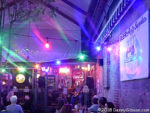
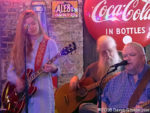
 On Friday night I took in some music at Cincinnati’s oldest bar, Arnold’s. A normal Friday night for me is playing trivia but, with the NCAA tournament getting revved up, that was canceled due to lack of interest and space. I looked online to see who might be playing and the fact that John Redell would be at Arnold’s caught my eye. Learning the Erin Coburn would be with him made it even more attractive and I’d already pretty much made up my mind to go when I found out the Dixon Creasy would also be there. Too cool. John is the ultimate mentor and, when not performing solo, spends a lot of his time making other people look good. That was the case when I last saw John and Erin together but not — at least not entirely — tonight. Erin can now readily hold her own and John permits himself to shine a bit more. A most enjoyable evening that included hearing a ukulele through a wah-wah live for the first time. That’s something everybody needs.
On Friday night I took in some music at Cincinnati’s oldest bar, Arnold’s. A normal Friday night for me is playing trivia but, with the NCAA tournament getting revved up, that was canceled due to lack of interest and space. I looked online to see who might be playing and the fact that John Redell would be at Arnold’s caught my eye. Learning the Erin Coburn would be with him made it even more attractive and I’d already pretty much made up my mind to go when I found out the Dixon Creasy would also be there. Too cool. John is the ultimate mentor and, when not performing solo, spends a lot of his time making other people look good. That was the case when I last saw John and Erin together but not — at least not entirely — tonight. Erin can now readily hold her own and John permits himself to shine a bit more. A most enjoyable evening that included hearing a ukulele through a wah-wah live for the first time. That’s something everybody needs.


 The fourth and final event to contribute to this post is my Saint Patrick’s Day breakfast. With its name inspired by the original owner’s pet chimpanzee, the Monkey Bar and Grill, on the Little Miami River, is undergoing what newspapers have referred to as a renovation. Transformation might be more accurate. One of the renovations not yet completed is the kitchen and the bar has been relying on food trucks for weekends and special occasions. Crappy weather threw a wrench (What kind of wrench was it?) into some outdoor plans but it didn’t keep Big Al’s BBQ from offering breakfast inside. Not the fanciest Saint Paddy’s breakfast I’ve ever had but it did the job and eating at the penny bar (20,000+ they say) was pretty cool.
The fourth and final event to contribute to this post is my Saint Patrick’s Day breakfast. With its name inspired by the original owner’s pet chimpanzee, the Monkey Bar and Grill, on the Little Miami River, is undergoing what newspapers have referred to as a renovation. Transformation might be more accurate. One of the renovations not yet completed is the kitchen and the bar has been relying on food trucks for weekends and special occasions. Crappy weather threw a wrench (What kind of wrench was it?) into some outdoor plans but it didn’t keep Big Al’s BBQ from offering breakfast inside. Not the fanciest Saint Paddy’s breakfast I’ve ever had but it did the job and eating at the penny bar (20,000+ they say) was pretty cool.

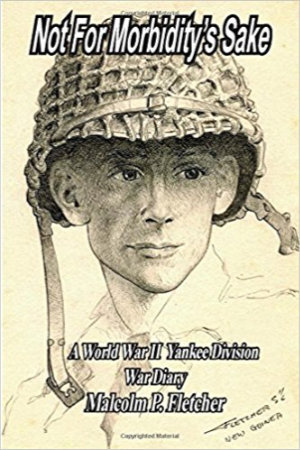 It’s a familiar story I’d never heard before. In no way is use of the word “familiar” meant to be dismissive. It’s just my way of acknowledging that many aspects of Malcolm Fletcher’s story are to be found in the stories of thousands of other World War II soldiers. Of course each of those stories is also unique in ways both small and large. Large happenings that make Fletcher’s story unique include the actions that earned him a bronze star and the day he watched his brother get shot and captured. Getting coffee and doughnuts from the Red Cross in February and washing clothes and shaving in May are among of the not-so-large pieces of the story that make it real. Numerous photographs, maps, and drawings — many by Fletcher himself — really fill things out.
It’s a familiar story I’d never heard before. In no way is use of the word “familiar” meant to be dismissive. It’s just my way of acknowledging that many aspects of Malcolm Fletcher’s story are to be found in the stories of thousands of other World War II soldiers. Of course each of those stories is also unique in ways both small and large. Large happenings that make Fletcher’s story unique include the actions that earned him a bronze star and the day he watched his brother get shot and captured. Getting coffee and doughnuts from the Red Cross in February and washing clothes and shaving in May are among of the not-so-large pieces of the story that make it real. Numerous photographs, maps, and drawings — many by Fletcher himself — really fill things out.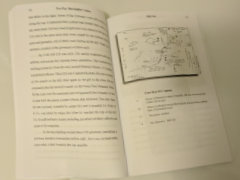 It’s a great story and well told but there’s no denying that the mere fact that it is being shared plays a big role in setting this story apart from most of those others. The majority of those soldiers never told their story to anyone. A relative few did write it down or record it but not many saw an audience beyond family, friends, or a veterans organization. That Malcolm Fletcher wanted to share his story is obvious. He expanded his wartime notes and produced a “diary”. The title is his. Not For Morbidity’s Sake came from the fact that, as his son Michael says in the foreword, “…he took no pleasure in telling most of this story”. Malcolm Fletcher died in 1994 and Michael, with help from his brother Mark, made publication of the diary a reality. To a large degree, this meant editing their father’s writings but they also augmented the story with information gathered from other family members, friends, and even some of the men who served with Malcolm.
It’s a great story and well told but there’s no denying that the mere fact that it is being shared plays a big role in setting this story apart from most of those others. The majority of those soldiers never told their story to anyone. A relative few did write it down or record it but not many saw an audience beyond family, friends, or a veterans organization. That Malcolm Fletcher wanted to share his story is obvious. He expanded his wartime notes and produced a “diary”. The title is his. Not For Morbidity’s Sake came from the fact that, as his son Michael says in the foreword, “…he took no pleasure in telling most of this story”. Malcolm Fletcher died in 1994 and Michael, with help from his brother Mark, made publication of the diary a reality. To a large degree, this meant editing their father’s writings but they also augmented the story with information gathered from other family members, friends, and even some of the men who served with Malcolm.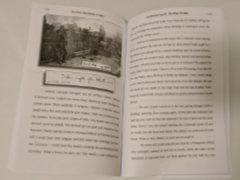 Those observations also fed some slightly philosophical thinking on the horrors of war and the brotherhood of man. He had personal experience with both. Whether the deeper of Fletcher’s thoughts came during his time in Europe or while he subsequently transcribed his notes in safety in the USA is unclear and unimportant. He was in the midst of battles where men destroyed each other with cannons, bombs, rifles, bayonets, and flame-throwers. He saw many and met a few French, Belgium, and German civilians whose world was ravaged beyond comprehension. And he was there at the end of the conflict interacting with German and Russian soldiers to learn that “These Russies are just like us.”
Those observations also fed some slightly philosophical thinking on the horrors of war and the brotherhood of man. He had personal experience with both. Whether the deeper of Fletcher’s thoughts came during his time in Europe or while he subsequently transcribed his notes in safety in the USA is unclear and unimportant. He was in the midst of battles where men destroyed each other with cannons, bombs, rifles, bayonets, and flame-throwers. He saw many and met a few French, Belgium, and German civilians whose world was ravaged beyond comprehension. And he was there at the end of the conflict interacting with German and Russian soldiers to learn that “These Russies are just like us.” It would be nearly impossible to spend any time at all around Cincinnati and not notice that its mural population has been increasing. I’ve noticed but I didn’t understand. I didn’t understand that ArtWorks Cincinnati, a name I sometimes noticed being associated with a new mural, wasn’t just a company hired to paint some pictures on some walls. I started to understand that aspect of Cincinnati’s murals just a little when ads for Transforming Cincinnati started to appear that included pieces of the back story. At that point I thought I understood the book’s title but, as I learned when I attended the big premier nearly two weeks ago, that was probably what I understood the least. The official launch took place on November 18 at a “Book Premier & Artist Signing” hosted by Joseph-Beth Booksellers. I attended with the idea of getting a copy with a few autographs in it. I got so much more.
It would be nearly impossible to spend any time at all around Cincinnati and not notice that its mural population has been increasing. I’ve noticed but I didn’t understand. I didn’t understand that ArtWorks Cincinnati, a name I sometimes noticed being associated with a new mural, wasn’t just a company hired to paint some pictures on some walls. I started to understand that aspect of Cincinnati’s murals just a little when ads for Transforming Cincinnati started to appear that included pieces of the back story. At that point I thought I understood the book’s title but, as I learned when I attended the big premier nearly two weeks ago, that was probably what I understood the least. The official launch took place on November 18 at a “Book Premier & Artist Signing” hosted by Joseph-Beth Booksellers. I attended with the idea of getting a copy with a few autographs in it. I got so much more.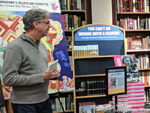
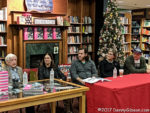
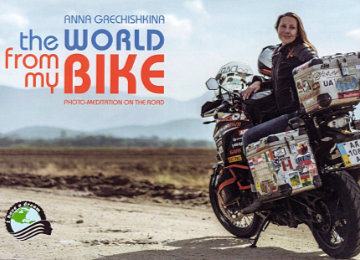 Wow! This is one of the most captivating books I have ever held in my hands. It is the product of one of the most determined woman I have ever met on one of the most exciting adventures I can imagine. Claiming to have met Anna Grechishkina is actually something of a stretch. At the 2014 Route 66 Festival in Kingman, Arizona, she joined some festival attendees for dinner. Our “meeting” consisted of a second or so of eye contact and a group hello. But I learned of her dream and her plans to fulfill it and I have followed her journey from that point on.
Wow! This is one of the most captivating books I have ever held in my hands. It is the product of one of the most determined woman I have ever met on one of the most exciting adventures I can imagine. Claiming to have met Anna Grechishkina is actually something of a stretch. At the 2014 Route 66 Festival in Kingman, Arizona, she joined some festival attendees for dinner. Our “meeting” consisted of a second or so of eye contact and a group hello. But I learned of her dream and her plans to fulfill it and I have followed her journey from that point on.
 This could be the charm associated with third attempts, or it could be the out associated with third strikes. Seriously, though, I doubt it is either. Neither of my first two books,
This could be the charm associated with third attempts, or it could be the out associated with third strikes. Seriously, though, I doubt it is either. Neither of my first two books,  I wish I had $6 or even 6¢ for every time I’ve stood by an old motel or diner and wished that the aging walls could talk. There are no talking walls here but 2 for $6 on Route 66 does contain the memories of someone who spent a whole lot of time with some very interesting walls. Author Debra Whittington married into the motel business; The man she married was born into it.
I wish I had $6 or even 6¢ for every time I’ve stood by an old motel or diner and wished that the aging walls could talk. There are no talking walls here but 2 for $6 on Route 66 does contain the memories of someone who spent a whole lot of time with some very interesting walls. Author Debra Whittington married into the motel business; The man she married was born into it. You can’t judge a book by looking at the cover. Or, sometimes, by reading the title. That was the case for me with Onramps and Overpasses and the impression I got from the title and cover pretty much explains why it stayed on the unread pile so long that I don’t remember where it came from or why I have it. The cover is a nicely done long exposure photo of cars on a divided four-lane highway passing through what looks to be a rather scenic area. The title reinforces the image of high-speed limited-access roadways. The subtitle, “A Cultural History of Interstate Travel” does a better job of describing what’s inside but the preconception created by the cover and title led me to overlook the word “cultural” and misinterpret the word “interstate”. In my opinion, Perrier goofed on the cover and even more so on the title. Those are, however, virtually the only mistakes she makes here.
You can’t judge a book by looking at the cover. Or, sometimes, by reading the title. That was the case for me with Onramps and Overpasses and the impression I got from the title and cover pretty much explains why it stayed on the unread pile so long that I don’t remember where it came from or why I have it. The cover is a nicely done long exposure photo of cars on a divided four-lane highway passing through what looks to be a rather scenic area. The title reinforces the image of high-speed limited-access roadways. The subtitle, “A Cultural History of Interstate Travel” does a better job of describing what’s inside but the preconception created by the cover and title led me to overlook the word “cultural” and misinterpret the word “interstate”. In my opinion, Perrier goofed on the cover and even more so on the title. Those are, however, virtually the only mistakes she makes here.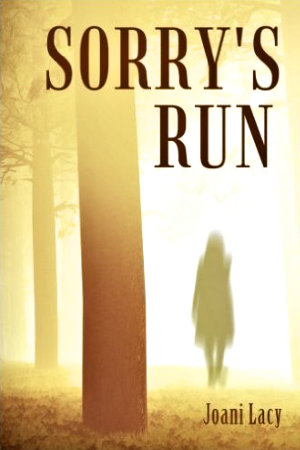 I’ve not read a lot of fiction lately. I used to. There was a time when I sucked down a fair amount of science fiction and historical fiction along with a smattering of aged classics. Sorry’s Run is none of those. It is, however, just about everything else. If pressed to place it under a single heading, I guess I’d call it a mystery. It’s a mystery where learning what was done is at least as much fun as learning who done it. Beneath the book’s central plot is an intriguing layer of occult, a tolerable touch of romance, and frequent and appreciative glimpses of the Ohio River and the country it flows through. It is set in the real world of today although it’s a world whose edges are not always crisply defined.
I’ve not read a lot of fiction lately. I used to. There was a time when I sucked down a fair amount of science fiction and historical fiction along with a smattering of aged classics. Sorry’s Run is none of those. It is, however, just about everything else. If pressed to place it under a single heading, I guess I’d call it a mystery. It’s a mystery where learning what was done is at least as much fun as learning who done it. Beneath the book’s central plot is an intriguing layer of occult, a tolerable touch of romance, and frequent and appreciative glimpses of the Ohio River and the country it flows through. It is set in the real world of today although it’s a world whose edges are not always crisply defined. The review of this book published in April 2017 has gone missing. Maybe I accidentally deleted it or maybe a slightly down level backup was restored and I didn’t notice. Whatever happened, I’m confident it was my fault. I’m not going to try to reproduce the whole review. I’m just trying to head off the “not found” errors — and encourage everyone to buy a copy.
The review of this book published in April 2017 has gone missing. Maybe I accidentally deleted it or maybe a slightly down level backup was restored and I didn’t notice. Whatever happened, I’m confident it was my fault. I’m not going to try to reproduce the whole review. I’m just trying to head off the “not found” errors — and encourage everyone to buy a copy. This book was first published in 1890. The link at the end of this article points to a version published barely a month ago. Despite it being well over a century old, some think it worth reading and someone considers it worth republishing. Why others consider the 127 year old writing worth reading I cannot say but I know why I enjoyed it. It’s filled with stories I’ve watched unfold on TV or in a movie theater or read as fiction. Those tales of frightened town folk, evil bullies, crooked sheriffs, and cowardly henchmen that thrilled me in my younger days were all legitimate. The basis of many plots played out in the numerous TV westerns of the 1950s and ’60s can be recognized in the real world events that Langford documents. This book is filled with characters very much like the assorted outlaws encountered by the horse riding heroes of my youth. Men similar to some of those heroes are also present although they don’t stand out quite as clearly. Few real world heroes wear a pair of pearl handled revolvers and a white hat.
This book was first published in 1890. The link at the end of this article points to a version published barely a month ago. Despite it being well over a century old, some think it worth reading and someone considers it worth republishing. Why others consider the 127 year old writing worth reading I cannot say but I know why I enjoyed it. It’s filled with stories I’ve watched unfold on TV or in a movie theater or read as fiction. Those tales of frightened town folk, evil bullies, crooked sheriffs, and cowardly henchmen that thrilled me in my younger days were all legitimate. The basis of many plots played out in the numerous TV westerns of the 1950s and ’60s can be recognized in the real world events that Langford documents. This book is filled with characters very much like the assorted outlaws encountered by the horse riding heroes of my youth. Men similar to some of those heroes are also present although they don’t stand out quite as clearly. Few real world heroes wear a pair of pearl handled revolvers and a white hat.